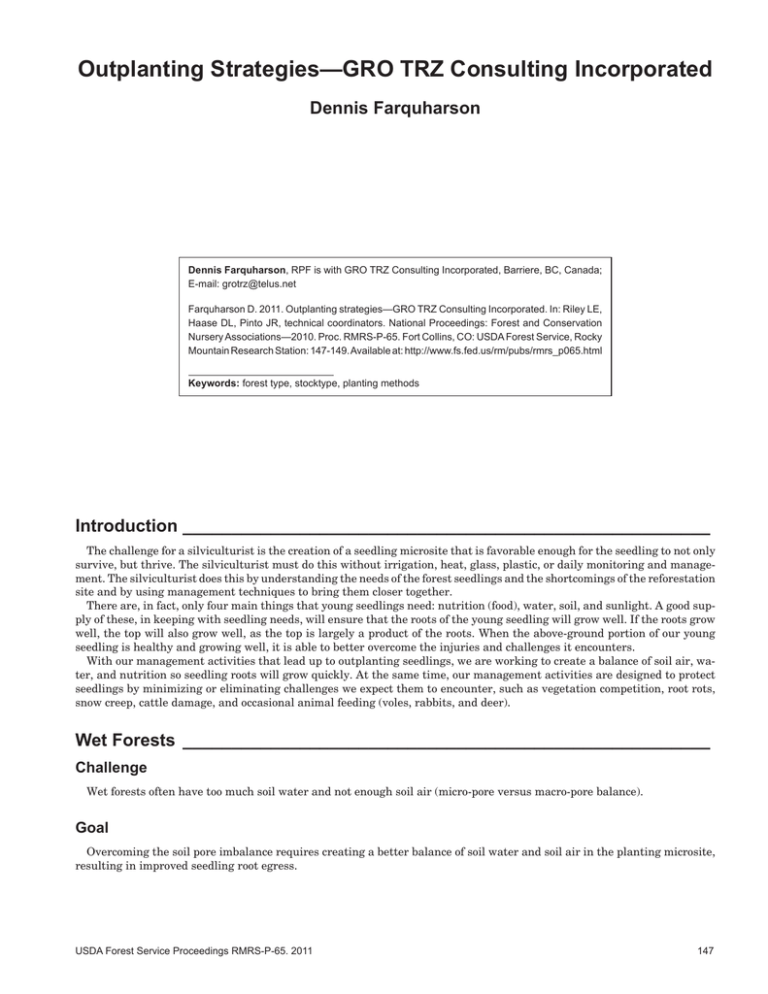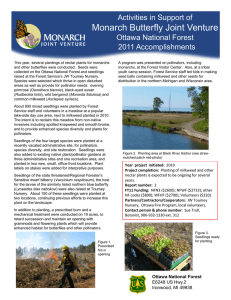Outplanting Strategies—GRO TRZ Consulting Incorporated Dennis Farquharson
advertisement

Outplanting Strategies—GRO TRZ Consulting Incorporated Dennis Farquharson Dennis Farquharson, RPF is with GRO TRZ Consulting Incorporated, Barriere, BC, Canada; E-mail: grotrz@telus.net Farquharson D. 2011. Outplanting strategies—GRO TRZ Consulting Incorporated. In: Riley LE, Haase DL, Pinto JR, technical coordinators. National Proceedings: Forest and Conservation Nursery Associations—2010. Proc. RMRS-P-65. Fort Collins, CO: USDA Forest Service, Rocky Mountain Research Station: 147-149. Available at: http://www.fs.fed.us/rm/pubs/rmrs_p065.html Keywords: forest type, stocktype, planting methods Introduction_______________________________________________________ The challenge for a silviculturist is the creation of a seedling microsite that is favorable enough for the seedling to not only survive, but thrive. The silviculturist must do this without irrigation, heat, glass, plastic, or daily monitoring and management. The silviculturist does this by understanding the needs of the forest seedlings and the shortcomings of the reforestation site and by using management techniques to bring them closer together. There are, in fact, only four main things that young seedlings need: nutrition (food), water, soil, and sunlight. A good supply of these, in keeping with seedling needs, will ensure that the roots of the young seedling will grow well. If the roots grow well, the top will also grow well, as the top is largely a product of the roots. When the above-ground portion of our young seedling is healthy and growing well, it is able to better overcome the injuries and challenges it encounters. With our management activities that lead up to outplanting seedlings, we are working to create a balance of soil air, water, and nutrition so seedling roots will grow quickly. At the same time, our management activities are designed to protect seedlings by minimizing or eliminating challenges we expect them to encounter, such as vegetation competition, root rots, snow creep, cattle damage, and occasional animal feeding (voles, rabbits, and deer). Wet Forests_______________________________________________________ Challenge Wet forests often have too much soil water and not enough soil air (micro-pore versus macro-pore balance). Goal Overcoming the soil pore imbalance requires creating a better balance of soil water and soil air in the planting microsite, resulting in improved seedling root egress. USDA Forest Service Proceedings RMRS-P-65. 2011 147 Outplanting Strategies—GRO TRZ Consulting Incorporated Farquharson Management Alternatives Goal 1. Plant with shorter plug stock, such as Styroblock™ 410 (10.4 cm [4.1 in] length) or 412 (11.7 cm [4.6 in] length) containers. Planting seedlings with shelter may make them more robust before they experience snow creep. This will also improve the growing conditions so that the seedlings will grow faster and be stronger, enabling them to better repair themselves when they are damaged. 2. Plant raised microsites. 3. Reduce tree spacing to allow clumpy planting of raised microsites. 4. Plant undisturbed organic F- and H-layer microsites and set seedlings with a small amount of compaction of the organic soil. 5.Plant mineral/organic mixed soil raised microsites created by an excavator if the soil is not too wet. Management Alternatives 1. Plant larger 2-year old stock, such as seedlings grown in Styroblock™ 512 (220 cm3 [13.4 in3] volume) or 615 (336 cm3 [20.5 in3] volume) containers, and fertilize them (usually interior spruce). 6. Plant with western redcedar (Thuja plicata) or interior spruce (Picea glauca (Moench) Voss X Picea engelmannii Parry ex. Engelm.). 2. Obstacle plant as many seedlings as possible beside stumps and downslope of anchored logs. Peel the bark off stumps adjacent to seedlings so the bark does not fall off onto seedlings. Cold Forests____________________ 3.If possible, use excavator site preparation to create raised screefs and place logs for planting obstacles. Challenge 4. Plant in late spring (mid June). Cold forests often have too much soil water and not enough soil air in a cool climate, resulting in soils that are too cold for good root growth. Rich Moist Forests______________ Goal Heavy vegetation competition can result in physical damage from vegetation pressing the seedling to the ground in fall and winter. Seedlings may not be able to straighten up again the next spring. The lack of sunlight and, therefore, food resources will affect seedling form, and may reduce health and vigor. Improving the soil water/soil air balance will enable air to penetrate the planting microsite more easily and warm the planting soil. Management Alternatives 1. Use excavator site preparation to create “raised screefs” made up of upper (more fertile) soil horizons (F, H, A, and B). Incorporating the organics with the mineral soil helps to aerate the soil as well. 2. Plant in late spring (mid June) or fall (mid September). Soil during summer planting (mid July) is often too dry, resulting in no root growth until the fall moisture arrives. 3.Plant interior spruce in shorter stock sizes, such as seedlings grown in Styroblock™ 410 (10.4 cm [4.1 in] length) or 412 (11.7 cm [4.6 in] length) containers, to keep the roots in the preferred warmer, shallower soils. Heavy Snow Forests_____________ Challenge Physical damage can result from heavy snow and snow creep. Slow growth can be the result of cold, wet soils. 148 Challenge Goal Forecasting the type, extent, and timing of the vegetation competition can allow appropriate pre-emptive actions to be taken to reduce the vegetation competition. Reducing vegetation competition when it does develop will reduce the adverse effects on the young tree. Management Alternatives 1. Site prepare the cut block as appropriate (depending on the type of vegetation competition complex expected) to improve the growth performance of the seedlings and reduce the influence of the vegetation competition for a period of time (a few years or more). Excavator-raised screefs will reduce the competition for a few years; the excavator can also root out vigorous shrubs when necessary. 2. Plant promptly prior to establishment of the competing vegetation. USDA Forest Service Proceedings RMRS-P-65. 2011 Farquharson 3. Plant larger stock, such as seedlings grown in Styroblock™ 412 (125 cm3 [7.6 in3] volume), 512 (220 cm3 [13.4 in3] volume), or 615 (336 cm3 [20.5 in3] volume) containers, and fertilize them to improve strength, health, and performance. 4.Plant seedlings downslope of obstacles (stumps and logs) so seedlings are protected from upslope herbs and shrubs falling down onto them. 5. Herbicide or brush to release the seedlings and young crop trees from the competition. Implement appropriate strategies for each so as to be effective with the treatment while minimizing herbicide use. Droughty Forests________________ Challenge A lack of moisture available to the seedlings during their sensitive establishment years can lead to mortality. As seedlings grow, their moisture demand increases; in a droughty year, moisture demand may exceed the supply, resulting in mortality. Outplanting Strategies—GRO TRZ Consulting Incorporated 5. Plant as early as possible in the planting window to allow the longest moist period possible for seedlings to establish. 6. Do not replant the area unless you are sure that you made a mistake that led to the observed mortality; otherwise it will happen again. Douglas-fir Forest Type__________ Challenge Interior Douglas-fir (Pseudotsuga menziesii var. glauca) is challenging to reestablish and more costly than other local species; at the same time, it is a very common and relatively valuable species. It is also considered to be a keystone species for our region in the face of expected climate change. Goal Effective re-establishment of interior Douglas-fir and reduction of cost has become a goal in this forest type. Management Alternatives Goal Drought-challenged forest areas need to be identified prior to reforestation, and a strategy to establish and grow the best young forest possible needs to be implemented by planting into larger soil pockets or reducing moisture competition. Management Alternatives 1. Ensure that the stocking expectation is reasonable for the degree of drought that the site will experience. 2. Order planting stock grown in Styroblock™ 410 (10.4 cm [4.1 in] length) containers to facilitate proper planting in shallow soils. 3. Site prepare the area as possible to reduce moisture competition to the seedlings. 1. Some site preparation seems to help. The selection of planting locations with ample soil fertility, soil porosity, and soil moisture appear to be very important. 2. Douglas-fir reestablishment seems to be more effective with larger stocktypes, for example, seedlings grown in Styroblock™ 412 (125 cm3 [7.6 in3] volume) containers. 3. Tea bag fertilization at the time of planting also helps. It is especially noticeable on the moist and wet areas. We use high nitrogen mixes with elevated levels of sulphur; our lack of natural sulphur restricts the utilization of nitrogen. 4.Manage competition throughout the establishment phase, until they are around 1.3 m (4.3 ft) tall. Once seedlings have reached this target, they seem to become more resilient and able to better deal with challenges. 4. Teach planters where to look for deeper pockets of soil in rocky areas. The content of this paper reflects the views of the authors, who are responsible for the facts and accuracy of the information presented herein. USDA Forest Service Proceedings RMRS-P-65. 2011 149





